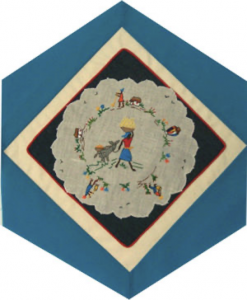Haiti

The Block
This block features colourful scenes of everyday Haitian life. It was hand-embroidered by Kettly Hamilton onto a piece of scalloped-edged linen, and finished with fine picots. The background consists of gros bleu (indigo-dyed chambray), an important fabric in Haiti, and is outlined in red, one of the country’s national colours.
Cultural Profile
Haiti is an independent republic of the West Indies and home to the famous Albert Schweitzer Hospital, which trains medical specialists in tropical diseases. The country occupies the western third of the island formerly known as Hispaniola (La Isla Española) and produces some of the world’s finest coffees. The name ‘Haiti,’ meaning ‘mountainous country,’ was given to the land by the former Taino-Arawak peoples, an indigenous group that originally inhabited the island. The country gained its independence in 1804 after a successful slave revolt, a fact that most Haitians take great pride in. Almost 95 percent of Haitians are of African origin; the other five percent are mulatto (African-French), and European descent. The official languages are French and Creole, which uses both colonial French and West African phrases and words. Though largely Christian, many Haitians still practice some voodoo rites, a spirituality brought over from West Africa during the slave trade.
Haitian culture blends African, French, and West Indian elements and includes a long tradition of proverbs, jokes and riddles, and storytelling such as the stories of ‘Tonton Bouki et Ti Malice’ (Uncle Bouki and Little Malice). Haitian literature, most often written in standard French instead of Haitian Creole, is known worldwide thanks to authors such as Jean-Price Mars, Jean Métellus, René Depestre, Frankétienne and Dany Laferrière.
Music and dance, influenced by many different sources including American jazz and Cuban styles, play an integral part in Haitian lives. Haitians express their love for both in bamboches, social gatherings where the dancing is pou’plaisi’ (for pleasure) on the rhythms of konpa, twoubadou (troubadour) and zouk music. Haitians also combine work with pleasure through the combite, a communal working party held when family or friends need help with a large work project.
Haitians are also known for their weaving, embroidery, brightly coloured clothing, woodcarving, and basketry. Artisans also use bosmétal, recycled metal to produce jewellery or household objects, papier maché to make vases or handbags or animal horns for various objects.
Around 2 million Haitians live abroad, mostly in the United States, Canada and the Dominican Republic. Even though they do not live in their homeland anymore, they still play a large part in the country’s economy through remittances that amount to a quarter of the GDP each year. Large-scale immigration of Haitians to Canada began in the 1970s. Many people left their homeland because of political problems, poverty and the lack of job opportunities, and most settled in Québec because of their fluency in French. Haitian immigrants fulfilled many of Québec’s economic needs for doctors, nurses, teachers and journalists. Trades people and service workers contributed to the industrial and commercial development of urban Québec through Haitian restaurants, clothing outlets, and book and music stores. Haitians have also influenced Canadian life in general in such areas as politics, sports, journalism, and music. Her Excellency Michaëlle Jean, former Governor General of Canada, and Bruny Surin, Dany Laferrière, Régine Chassagne, Adonis Stevenson, Luck Mervil, Stanley Péan, and Jean Pascal, household names in Québec, are all of Haitian descent. They demonstrate the valuable contributions the community has made to Canada. Montréal is currently home to 100,000 Haitians while others largely reside in the Ottawa-Hull and Toronto areas. The 2011 census lists a total of 138,000 Haitians living in Canada.
Sponsor: Glen Walter and Area Chamber of Commerce
